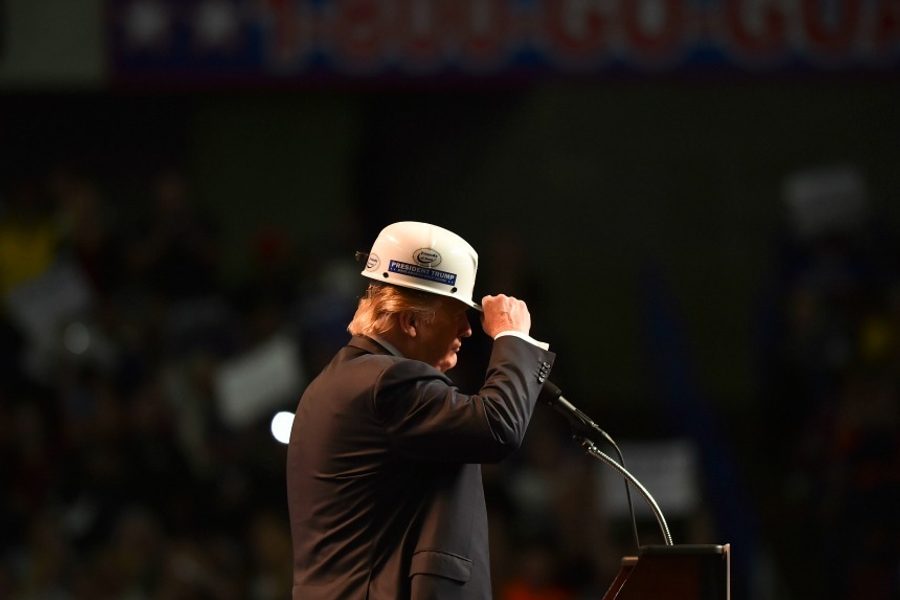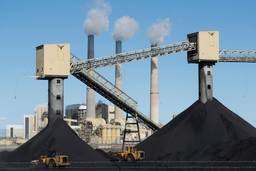A Climate Scientist On Why Trump Pulling Out of the Paris Accord Won’t Be the End of the World
Trump’s announcement certainly is not good, but all hope may not be lost.
Kate Aronoff

Donald Trump announced today that he’ll pull the United States out of the Paris Agreement, which would make the country just one of three worldwide — joining Nicaragua and Syria — to refuse participation in the landmark climate deal. Trump claimed “we are getting out, but we will start to negotiate and see if we can make a deal that’s fair.”
With today’s declaration, Trump kicked off a four-year process that could eventually be reversed by his successor and will involve numerous bureaucratic hurdles. With or without the United States, however, all countries will need to drastically ratchet up their plans for reducing emissions to get anywhere close to meeting the goals set out in Paris in 2015.
While news about climate change often raises fears that the end of the world is coming, today’s announcement may not be as bad as it seems. Trump’s move is troubling, but climate scientist Glen Peters suggests that the mood need not be all doom and gloom. I spoke with Peters, a senior researcher at Norway’s CICERO Center for International Climate Research, about Trump, what’s next for the Paris Agreement and why not all hope is lost.
Kate Aronoff: You don’t think Trump pulling out of the Paris Agreement is the end of the world. Why’s that?
Glen Peters: Trump has pretty clearly indicated he’s not going to do anything about climate, so whether he’s in or out of Paris probably isn’t going to affect U.S. emissions so much. You could argue that, if he’s going to go slow and be a wrecker, then the United States is better suited to be out than in. Once the United States withdraws, then they can’t take part in those discussions. Internationally I don’t think it will change other counties’ positions too much. If anything, it might strengthen their positions. There’ll certainly be a country or two that will say, “The United States isn’t doing anything, so we’ll weaken our commitments.” But I think there’ll be many other countries that will be willing to take on more of a leadership role and essentially give Trump the finger by doing even better.
Another point is that the United States is a big emitter, accounting for about 15 percent of global emissions. But that leaves 85 percent. If the rest of the world is doing a lot, then it could quite easily offset four years of sideways movement in the United States. So, I certainly wouldn’t say it’s the end of the world.
Kate: The worst-case scenario people seem to be thinking about is that Trump pulls out and repeals a lot of regulations and pumps a bunch of money into the United States’ extractive and high-polluting industries, setting the stage for emissions to be much higher than they have been. Do you think that’s on the table?
Glen: He’ll probably do that, and he’s said he wants to unwind a number of things. But it’s not a question of whether he wants to put more money here, there or anywhere. It’s whether an investor wants to put his or her money into something. If [Trump] says he’s going to bring back coal, that’s very different from an investor saying, “I’m going to come in and build a brand-spanking-new, coal-fired power plant that’ll sit around for 50 years.” I think that would be an exceedingly reckless investor, especially if Trump is going to get kicked out.
Whether it’s four years or eight years, he’ll be gone soon. Maybe his successor will be a Democrat, the mood will have changed and U.S. climate policies will become significantly stronger. So, you’d have to be a really risk-taking investor to put your money in carbon-intensive industries now. It’s just too risky over the long term.
And if you’re a car producer, you probably won’t produce different cars for the United States, just because Trump has relaxed the regulations, and then produce an alternative set of cars for the rest of the world. I just don’t know what the logic would be in saying, “We’ve got a president for four years who’s going against the grain. Let’s change our industrial processes and pretend he’s going to be around for 400 years.”
Still, emissions will certainly be [greater] under him than what you might have expected under Clinton. The biggest difference is that he won’t be implementing new policies to drive down emissions, whereas a Democrat or even another Republican might have. In a sense, I don’t think the United States will lose ground, but it won’t pick up speed either. It’ll be more of a stagnation.
Kate: Putting Trump aside for a second, what are the next steps for the Paris Agreement? What needs to come out of negotiations over the next several years to get anywhere near the goals laid out within it?
Glen: The most important thing now is establishing a rulebook — or whatever you want to call it — that’s written in a way that you can see what countries are doing, measure and verify what they’re doing and make sure there’s a mechanism to raise and measure ambition. All of those processes need to be put in place to make sure these commitments are followed through on and that countries do raise their ambition. Paris is essentially a voluntary thing, so there’s no punishment if countries pull out. You need that sort of peer-pressure-based, name-and-shame system to ensure countries do their bit. Obviously it’s not working with the United States. The fact that the United States could pull out without any repercussions shows one of the weaknesses of Paris.
Paris is set in place and is now in the implementation phase. That’s always boring. What number are you going to put over here and what are you going to call this line? What date will we do this by? It’s all sort of boring, yet it’s the stuff that makes it work. If Paris is the decision to fly to the moon, the next five years is when you figure out how you’re actually going to do it. You build your satellite, set your goals and then you get down to business.
Kate: Are there any other mechanisms with which other nations can reprimand the United States for pulling out?
Glen: Other countries could use a Border Carbon Adjustment as a retaliatory measure. Usually what that means is that you place a tax on imports into the country based on their carbon content and give a subsidy to the exports. It’s a bit like a value-added tax. It sort of levels the playing field, but in a retaliatory measure you may not be so careful about whether the tax is set exactly to the carbon content of the imports. You might just slap a dollar or some other arbitrary price on whatever is imported. You could be a bit more crude. Those sorts of disciplinary mechanisms aren’t inscribed into the agreement, so that would be an action that countries could decide amongst themselves to use against the United States.
But the United States might retaliate and do the same, and then you just end up in some horrible spiral. The United States is a powerful player in the global economy, so they can cause just as much damage as other countries could with border adjustments. That’s probably not the best path to go down. It could cause a trade war situation where everyone might lose. It all starts to get quite complex and bleeds into policy areas other than climate.
Around the G7, Angela Merkel was basically saying that Europe no longer needs the United Kingdom and the United States. If the United States is not going to play the international game, I’m sure things will be more difficult for them in other places. I think what’s probably the most effective path forward is for other countries to say that, if the United States wants something, they’re going to play hardball. They’ve got nothing to lose, in a sense.
Kate: Hoping that the next president takes a more progressive stance on climate change than Trump, what does picking up the pieces from his administration look like?
Glen: It depends on who the president is, of course. Even if Trump wants to unwind stuff, that’ll take several years. And it may take several years to wind things back up again. The mood of the nation can change quickly. If the United States isolates itself over the next four years, there could be a lot of momentum for a kind of re-integration. It’s all speculative and hard to see. If there was a change toward a pro-climate direction, it’d be a slow process of getting regulations put in place. These things always take time. I’m sure there’ll be excitement, but in practice it’ll take some years to get things moving again.
Kate: Could you talk briefly about where Global North countries like the United States need to go in terms of bringing down emissions?
Glen: A paper came out a couple of months ago which put it quite nicely. Fossil fuel emissions need to be cut in half every decade, and you would need to hit zero emissions by about 2050 or so. That’s the scale. Rich countries would have to go a little bit faster, and developing countries a little bit slower. Across the board, though, everyone needs to do a pretty significant task. Even developing nations can’t have too much more space, because there just isn’t that much more space. The space is basically gone. This gets into the crux of why I say 2 degrees is more or less infeasible. It’s not just a few countries that have to do the heavy lifting. It’s pretty much everybody that has to be getting toward zero by 2050.
Kate: Is that with or without negative emissions?
Glen: That scenario — net zero by 2050 — would be with negative emissions. That paper included five billion tons of negative emissions by 2050 in its projections. Those are pretty big numbers, and would mean pretty drastic changes to the energy system.
Kate: What is the impact of a Trump administration on the kind of research and investment needed to bring negative emissions to scale? Can he screw that up?
Glen: He’s already wound back some options for research and development and innovation. If you want to get those technologies really moving then you need to start investing big time in research and development. If you’re not doing that, then that’s not going to happen. There was some sense early on that Trump would be supportive of CCS (carbon capture and storage) and would move things along, but he’s a bit negative to that as well now.
Kate: He talks about “clean coal” all the time.
Glen: Right, but he’s also wound back on research programs required to make CCS really happen. So, what clean coal means to him might be different than what it means to us. Again, if you’re an investor looking at investing in this kind of technology, you’re talking about a 40 or 50-year investment, so you want to make sure you have the right policy environment. There aren’t very many companies willing to take that risk. Companies weren’t ready to take that risk under Obama and he was more pro-climate.
Kate: Well that’s all fairly depressing. To end on a more hopeful note, what would you tell someone who’s despairing about Trump pulling out the Paris Agreement. What’s your message of hope on this?
Glen: To borrow a phrase, “It’s the economy, stupid!” If you look back at the last 10 years, part of the reductions in the United States have been linked to slower economic growth. It’s not as if Obama brought in any big climate policies that really changed the direction of things during his term. It was economics that changed. That’s where the hope is: That some of these technologies becoming cost-competitive without policy shifts.
Kate Aronoff is a staff writer at The New Republic and author of Overheated: How Capitalism Broke the Planet — And How We Fight Back. She is co-author of A Planet To Win: Why We Need a Green New Deal and co-editor of We Own the Future: Democratic Socialism—American Style. Follow her on Twitter @katearonoff.








